7 Types Of HAWKS In Florida (ID Guide With Photos)
Did you recently come across a hawk in the state of Florida, and want to know what species it was?
Identifying hawks in the Sunshine State is not as easy as it might seem, since there are many hawk species in the state (as well as other Florida raptors that look similar).
To help you identify the bird you saw, we’ll cover the most common hawks of Florida in this article.

What types of hawks are found in Florida?
There are 7 different types of hawks commonly found in Florida, which are described in full detail below.
Red-tailed Hawk
Scientific name: Buteo jamaicensis
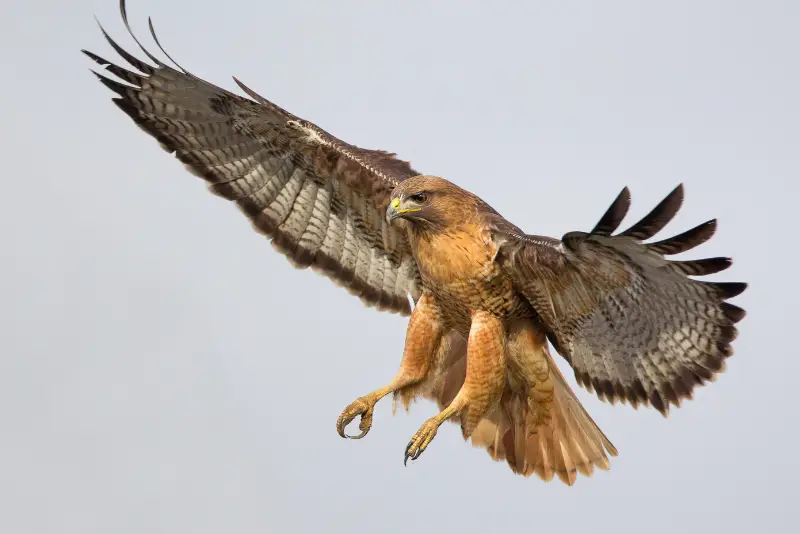
With a wingspan of up to 52 in (4.5 ft), the Red-tailed Hawk is the largest hawk species found in Florida.
It has variable coloration, ranging from dark brown to reddish to almost entirely white, but can be readily recognized by its rusty red tail.
These large hawks are common in open grassland habitats, but also in cities. They are most often seen perched on telephone poles, or roadside posts, waiting for prey.
It eats small mammals and other animals that it catches by swooping down from its perch when they venture out into the open.
The Red-tailed Hawk is the most common hawk found in Florida, and can be seen year-round in Florida.
Sharp-Shinned Hawk
Scientific name: Accipiter striatus
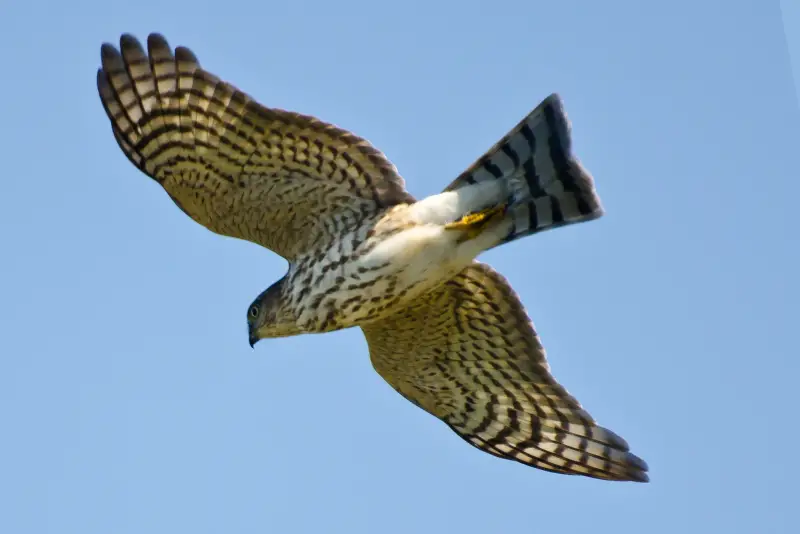
From the largest to the smallest bird on this list, the Sharp-shinned Hawk is the smallest hawk in Florida.
While these small hawks don’t breed in Florida, they regularly winter throughout the state outside of the breeding season.
Wintering birds are most often Sharp-Shinned Hawks from Canada that spend the cold season in the Sunshine State.
With blue-gray wings and back, and with orange feather patterns on their chests, these raptors are recognizable by their small size, agility, and distinctive behavior.
They are most often seen stalking song birds, making them a regular sight in Florida backyards during the winter.
Cooper’s Hawk
Scientific name: Accipiter cooperii
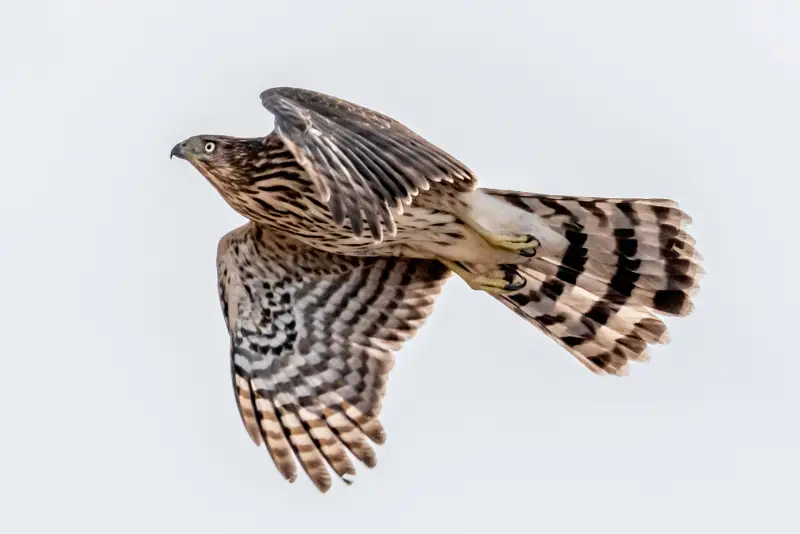
This little Florida hawk is agile and plenty of skill when it comes to catching small birds in flight. Sometimes it will even take species that are larger than itself.
Male Cooper’s Hawks have reddish-orange bars on their underside, while their upperparts are grayish-blue. The piercing eyes are vermillion red.
The long tail and small, rounded wings of the Cooper’s Hawk make it possible for this bird of prey to perform sharp turns and quick maneuvers in the thick foliage of dense forests and shrubs.
While these raptors were originally shy woodland birds, they are now commonly found in urban areas such as Miami and Fort Lauderdale, where they hunt pigeons and songbirds.
It is not unusual for this small hawk to show up at a bird feeder, where it tries to surprise and ambush feeding songbirds with a lightning fast dash from a hidden perch on a tall tree.
It is a winter visitor in the southern half of Florida, while it can be found year-round in the rest of Florida.
Red-shouldered Hawk
Scientific name: Buteo lineatus
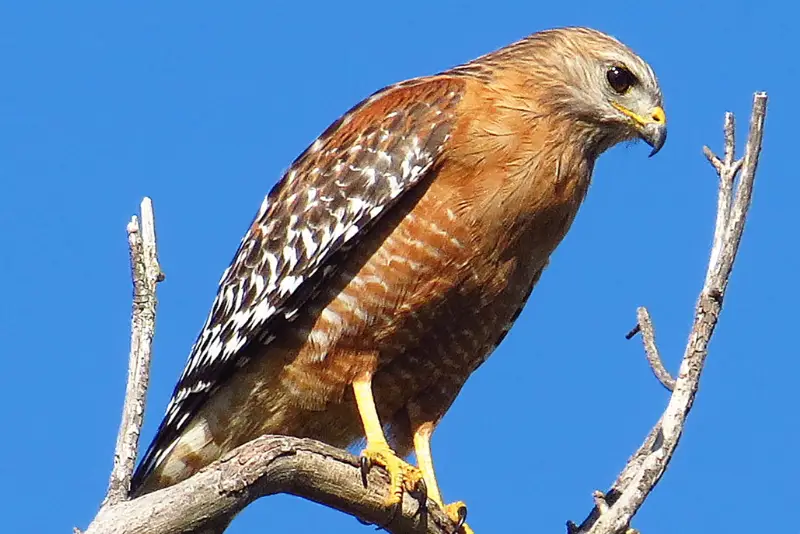
The Red-shouldered Hawk has two distinct populations – one in the eastern US (which includes the Florida population), and another in California and Mexico.
These two populations are separated by more than 1000 miles, and very rarely mix.
The Red-shouldered Hawk is found in lowland forests throughout Florida, where it favors mature woods interspersed with water.
The Florida population of the Red-shouldered Hawk is non-migratory, and adult birds stay in their nesting territories all year round.
Broad-winged Hawk
Scientific name: Buteo platypterus
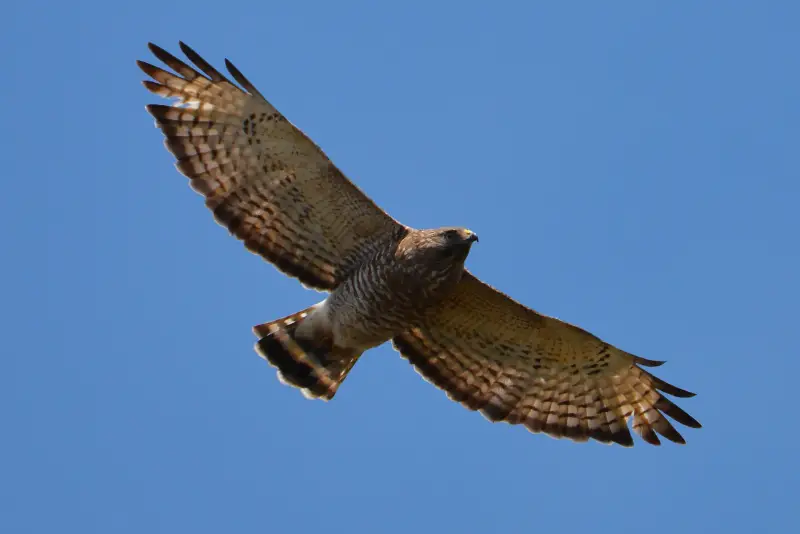
The Broad-winged Hawk is a long distance migratory species that spends the winter in South America.
During fall migration, it’s not uncommon to see large flocks (also known as “kettles”) of Broad-winged Hawks soaring together to take advantage of thermal currents on their way south.
The Broad-winged Hawk is a scarce breeding bird in the northernmost parts of Florida.
It can be seen more often during migration throughout Florida, and is a year-round resident in the southernmost parts of the state.
The preferred habitats of these medium-sized birds are extended forests, where the best way to detect them is by listening to their whistling call.
Short-tailed Hawk
Scientific name: Buteo brachyurus

The Short-tailed Hawk is primarily a species of Central and South America, but also has a small breeding population in Florida.
The Florida population of these raptors numbers only about 500 individuals, and consists mostly of its dark morph.
While Short-tailed Hawks in central Florida are migratory, they are year-round residents in south Florida.
Great places to see these medium-sized hawks are the Florida Keys (especially Key West), and the Everglades National Park.
Unlike most other buteo species, Short-tailed Hawks specialize in hunting small birds, which they attack with high speed dives from high altitudes.
Northern Harrier
Scientific name: Circus hudsonius
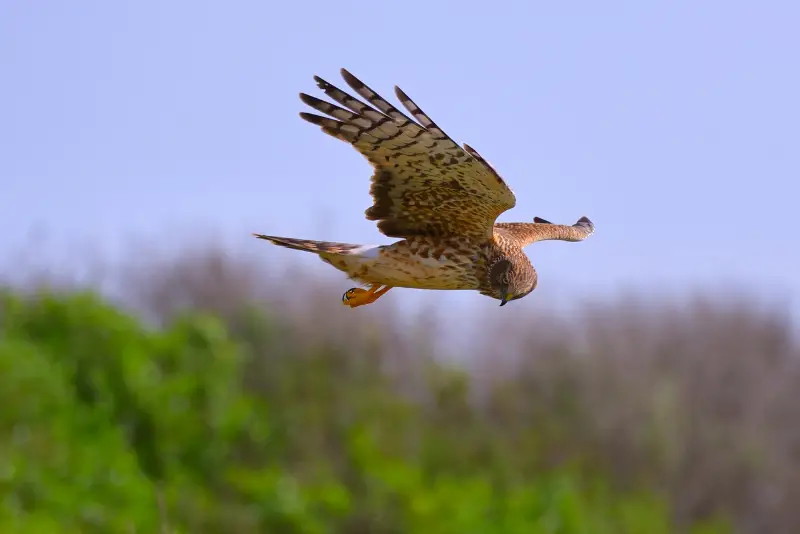
The Northern Harrier is a breeding bird of the northern parts of North America, but spends the winter in the southern USA and Central America.
This harrier is a winter bird in Florida from October through April, where it frequents open grassland and marshes.
Harriers are most easily identified by their behavior. Their foraging tactic is to fly slowly just a few feet above the ground, in order to pounce on any rodent caught outside its burrow.
Swainson’s Hawk (rare)
Scientific name: Buteo swainsoni
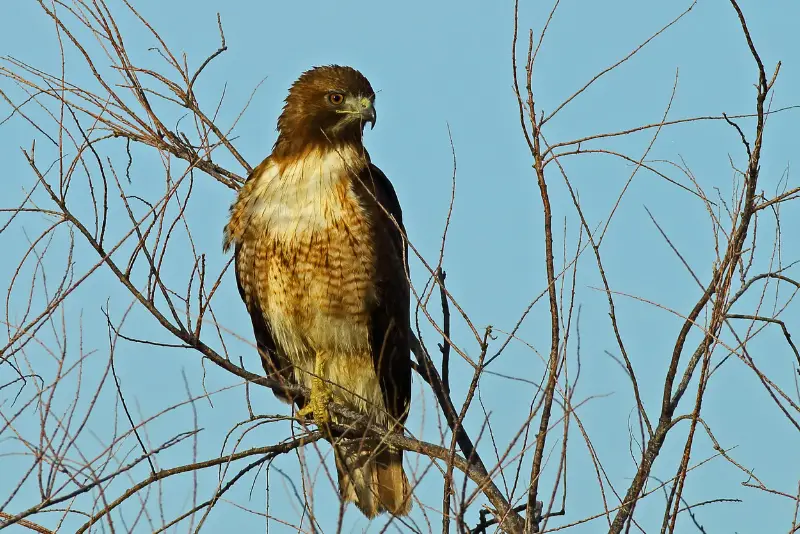
The Swainson’s Hawk is not a breeding bird of Florida, and its main range is found in the dry prairies and open areas of western North America.
However, this hawk is strictly migratory, and every winter a handful of individuals are encountered wintering in Florida, while the majority of the population migrates as far south as Argentina for the winter.
These raptors have long, narrow wings, and are best identified by their brown chest, which contrasts with the white underside of these hawks.
In fall they gather in flocks numbering in the tens of thousands that migrate south, often together with other species of hawks.
Swainson’s Hawks are summer visitors throughout the western half of North America, where this hawk can be found from April through September.
What Florida hawks have striped tails?
The following Florida hawks have stripes on their tails:
- Cooper’s Hawk
- Sharp-shinned Hawk
- Red-shouldered Hawk
- Broad-winged Hawk
- Northern Harrier
- Swainson’s Hawk
In Florida, the most common of these is the Cooper’s Hawk, which is regularly encountered in urban areas, and thus the first species to consider if you spot a hawk with a striped tail.
What Florida hawks are black and white?
There are two raptor species in Florida that are largely black and white: the Osprey and the Swallow-tailed Kite.
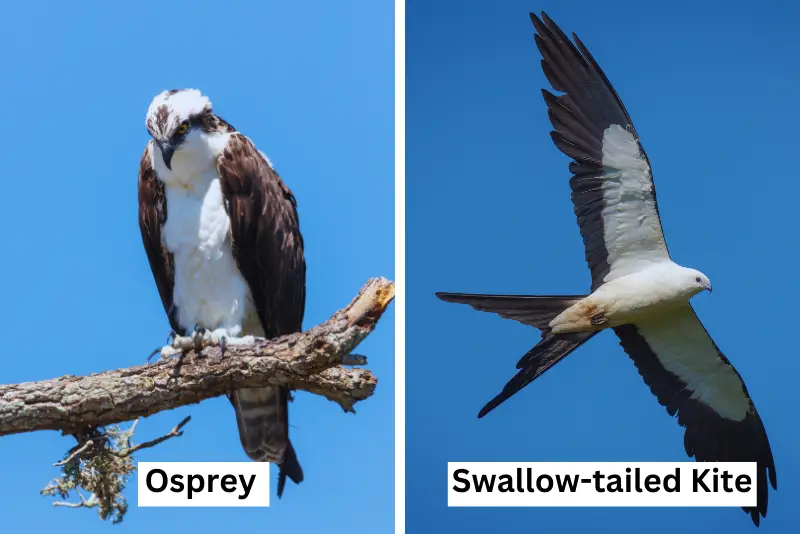
And while Ospreys and Swallow-tailed Kites are technically not hawks, they both resemble large black-and-white hawks, and belong to the larger family of Accipitridae, which includes all of the hawks covered in this article.
The Osprey is sometimes referred to as a “fish hawk” in the vernacular, since it feeds on fish that it catches by plunging into the water.
The Swallow-tailed Kite, on the other hand, is a skilled aerial hunter and capable of catching insects in flight. Its preferred food are small reptiles, rodents, and insects.
Final remarks
In summary, here are the 7 different species of hawks in Florida:
- Red-tailed Hawk
- Sharp-shinned Hawk
- Cooper’s Hawk
- Red-shouldered Hawk
- Broad-winged Hawk
- Short-tailed Hawk
- Northern Harrier
- Swainson’s Hawk (rare)
If you’ve spotted one of these hawks while bird watching in Florida, but aren’t sure which species it was, check our detailed identification guide with photos above.
And if you enjoyed this article, check out our guide to the kite birds of Florida.
